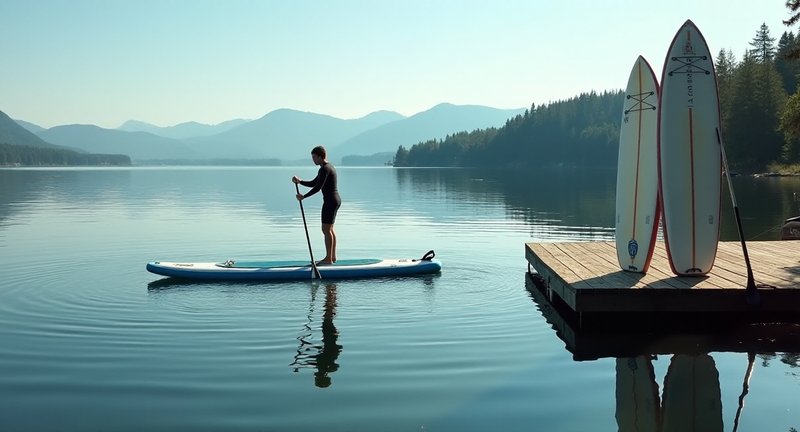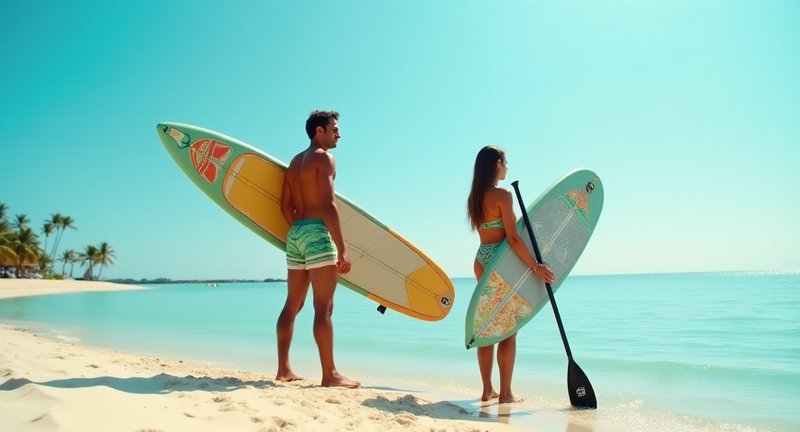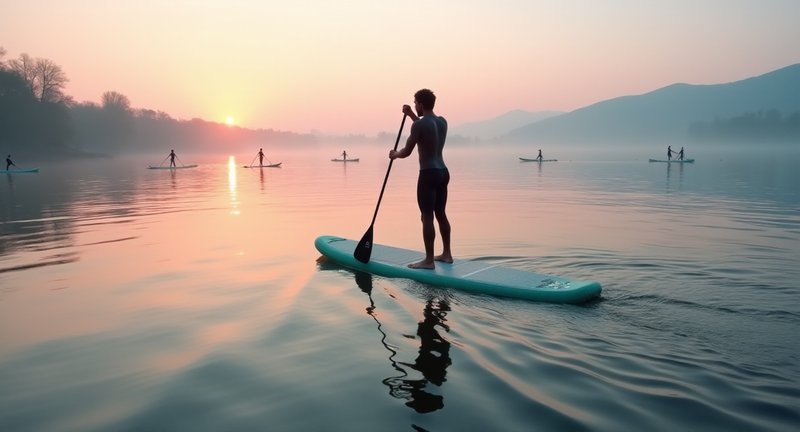A First Look at Paddle Board Size Guide
When I first dipped my toes into the world of paddle boarding, the sheer variety of boards left me feeling like a kid in a candy store. That’s when I stumbled upon the Paddle Board Size Guide, a game changer for anyone looking to navigate these waters.
Size matters, folks. Choosing the right paddle board isn’t just about aesthetics; it directly affects your experience on the water. I learned that length, width, and thickness all play a crucial role in stability and performance. If you’re aiming to glide gracefully across glassy lakes or tackle choppy ocean waves, the right dimensions will set you up for success.
In my quest for the perfect board, I discovered that shorter boards are ideal for maneuverability, while longer ones excel in speed and tracking. This was a revelation! I could finally understand why my friend struggled to keep up during our last paddle session it was all in the size.

Then there’s the width. Wider boards provide more stability, making them fantastic for beginners. I still remember my first wobbly attempts; a wider board would have saved me from a few unnecessary splashes.
So, if you’re diving into paddle boarding, don’t skip the Paddle board dimension overview. It’s your roadmap to choosing a board that fits your unique style and skill level. Trust me, investing time in understanding sizes will enhance your adventures and keep you cruising smoothly.
Choosing the Right Paddle Board Size Guide
As it relates to selecting the perfect paddle board, size matters a lot. From my adventures on the water, I’ve learned that getting the right dimensions can make the difference between gliding smoothly and battling choppy waves. Here’s what to consider when sizing up your board:
Length
- Short Boards (8-10 feet): Great for kids or those looking for a fun, agile ride in calmer waters.
- Medium Boards (10-12 feet): Perfect for all-around use. They balance stability and speed, making them ideal for most paddlers.
- Long Boards (12+ feet): These are for serious distance paddlers or those who enjoy racing. They slice through the water and maintain speed effortlessly.
Width
- Narrow Boards (28 inches or less): Designed for speed and efficiency, but they require good balance. Ideal for experienced paddlers.
- Wide Boards (30 inches or more): Super stable and great for beginners or those looking to enjoy a relaxed outing. You’ll feel like you’re floating on a cloud!
Thickness
- Thicker Boards (5 inches): Better buoyancy and stability, especially for heavier paddlers. These boards can hold up to more gear and provide a sturdy ride.
- Thinner Boards (4 inches): Generally lighter and faster, but may feel less stable, especially in choppy waters.
Weight Capacity
Always check the manufacturer’s weight recommendations. A board that can’t handle your weight might sink lower than you’d like, turning a sunny day into a soggy mess!

Remember, the best way to find your ideal board is to try a few out. Head to a rental shop, and give them a test paddle. There’s nothing like finding the board that feels just right beneath your feet!
Understanding Paddle Board Dimensions
In the matter of paddle boarding, understanding dimensions is like knowing the recipe for your favorite dish. The right board can make your experience feel like gliding on glassy waters or wrestling with waves. Let me share my insights on paddle board dimensions what I’ve learned on my adventures out there.
Key Dimensions to Consider:
-
Length:
- Typically ranges from 8 to 14 feet.
- Longer boards offer better speed and tracking, ideal for racing or longer distances.
- Shorter boards are more maneuverable, perfect for surf or tighter spaces.
-
Width:
- Common widths are 28 to 34 inches.
- Wider boards provide stability, great for beginners or yoga enthusiasts.
- Narrower boards help with speed but may sacrifice stability.
-
Thickness:
- Generally between 4 to 6 inches.
- Thicker boards support more weight and provide buoyancy.
- Thinner boards are lighter and more agile but can be less stable.
-
Volume:
- This refers to the board’s buoyancy and capacity.
- A higher volume means more stability and a larger weight capacity, making it easier to carry gear.
My Personal Tip:
I’ve often found that the best way to choose a paddle board is to consider your primary use. Are you planning a serene paddle on a calm lake or an adventurous day riding ocean swells? This will guide you in selecting dimensions that suit your paddling style.
Also, the right dimensions transform your paddle board from a mere flotation device into a trusty steed for aquatic escapades. So, take your time, weigh your options, and let your paddle board be an extension of your adventures.
Why Size Matters When Choosing a Board
In relation to choosing a board, size is like the magic wand of paddle boarding. Picture yourself gliding over the water; the right dimensions can either transform you into a graceful swan or leave you wobbling like a duckling.
A wider board offers stability, perfect for those who are just starting out or perhaps enjoying a leisurely paddle. It’s akin to having a trusty friend by your side, keeping you steady as you explore the gentle ripples of your local lake.
On the flip side, if you’re feeling adventurous, a narrower board can slice through the water like a hot knife through butter. This option is ideal for speed demons and those who relish the thrill of racing against the wind.
Consider your weight, too. A heavier person will want a larger board to avoid that unsettling feeling of being swallowed by the waves. It’s all about finding that balance where you feel both buoyant and confident.
I’ve found that the sweet spot often lies between stability and speed. For a casual day out, a board that’s slightly longer will offer you the best of both worlds, allowing you to cruise smoothly while still feeling agile enough to catch the occasional wave.
Also, it’s about aligning the board’s size with your personal style and the adventures you envision. Whether you’re looking to explore serene waters or conquer rougher seas, the right size can elevate your experience from ordinary to extraordinary.
Common Types of Paddle Boards
When I first ventured into the world of paddle boarding, I quickly discovered that not all boards are created equal. Each type offers a unique experience, catering to different styles and activities.
Let’s start with the all-rounder: the all-purpose paddle board. This board is like the Swiss Army knife of the water. It’s versatile enough for leisurely paddles, yoga sessions, or even catching a few waves if you’re feeling adventurous.
Next, there’s the touring paddle board. These beauties are designed for those who love to explore long distances. They glide through the water with ease, making them perfect for those extended outings on lakes or coastal adventures.
If you’re drawn to the ocean’s waves, you might want to check out the surf paddle boards. They’re shorter and more maneuverable, giving you the edge needed to ride those swells. Trust me, catching a wave on one of these boards is a thrill like no other!
For those seeking tranquility, the inflatable paddle board is a game-changer. These boards are lightweight and easy to transport, making them ideal for spontaneous trips. Plus, there’s something incredibly satisfying about inflating it on the beach and hitting the water within minutes.
Also, let’s not forget about the race paddle boards. If you’re looking to channel your inner competitor, these are built for speed. Narrow and sleek, they cut through the water like a knife, perfect for those who want to leave their friends in the wake.
So, whether you’re cruising along a serene lake or tackling ocean waves, there’s a paddle board out there that’s just waiting to join you on your aquatic adventures.
How Width Affects Stability
As for paddle boarding, width isn’t just a number; it’s a game changer. I’ve felt the difference myself, as a wider board cradles me like a friendly hug while I glide across the water.
Imagine standing on a tightrope. Now, picture how a wider plank would give you more confidence. That’s what width does for your stability. The broader the board, the more secure you feel, even in choppy waters.
During my adventures, I’ve noticed that beginners often gravitate toward wider boards. They’re like training wheels for the water. It’s fascinating to see how a little extra surface area can boost one’s confidence and make for a more enjoyable experience.
On the flip side, narrower boards have their own charm. They’re sleek and swift, perfect for those who crave speed. However, I’ve learned the hard way that they demand a bit more finesse and balance.
So, if you’re pondering your next purchase, consider how width influences your ride. A wider board might be your trusty sidekick on those lazy afternoons, while a narrower one could ignite your competitive spirit on open waters.
Also, it’s about finding the sweet spot that matches your style. Experimentation is part of the journey, and you might discover a newfound love for the art of paddle boarding.
The Importance of Length in Paddle Boards
When diving into the world of paddle boards, the length of your board can be a game-changer. Trust me, I’ve waded through the waters of choice, and here’s what I’ve discovered about why length matters so much.
Key Factors to Consider:
-
Stability vs. Speed:
- Shorter Boards (8-10 feet): Perfect for maneuverability and fun in small waves. Think of it like zipping around in a sports car quick and agile.
- Longer Boards (11-14 feet): Designed for speed and tracking. It’s akin to cruising in a sleek yacht, gliding effortlessly across the water.
-
Your Adventure Goals:
- Recreational Use: If you’re planning leisurely paddles in calm lakes, a shorter board might be your best bet.
- Racing or Touring: If you envision long, adventurous journeys or races, opt for a longer board to cover more distance with less effort.
-
Weight Capacity:
- Shorter Boards: Often have lower weight limits, making them ideal for lighter paddlers or solo adventures.
- Longer Boards: Usually support more weight, making them great for families or those wanting to bring along gear.
-
Personal Comfort:
- Choosing a board that feels good under your feet is crucial. A board that’s too long or too short can affect your overall enjoyment.
In my own journey, I learned the hard way that finding the right length can significantly enhance my paddling experience. So, before you choose, ponder over your needs, and remember each adventure is unique, much like you!
Ideal Thickness for Performance
In the matter of paddle boarding, the thickness of your board can make a world of difference in performance. From my personal escapades on the water, I’ve found that choosing the right thickness isn’t just about buoyancy; it’s about how the board interacts with waves, stability, and overall maneuverability. Here’s what I’ve learned:
Ideal Thickness Insights
-
Standard Thickness: Boards typically range from 4 to 6 inches in thickness. A 4-inch board is fantastic for speed and agility, while 6 inches provides more stability, especially for beginners or those carrying extra gear.
-
Water Conditions Matter: If you’re gliding over calm lakes, a thinner board will suffice, offering quick turns. Conversely, thicker boards shine in choppy waters, providing that comforting stability when the waves get a little wild.
-
Weight Capacity: Remember, thickness also influences how much weight your board can handle. Thicker boards generally support more weight, making them ideal for carrying passengers or gear.
-
Performance Tips:
- For Beginners: Opt for a thicker board. It’s your best friend for those initial wobbles.
- For Advanced Paddlers: Experiment with thinner boards to maximize speed and agility.
- Try Before You Buy: If possible, test different thicknesses. Feel how each board behaves under your feet; it’s the best way to find your perfect match.
Also, your choice should resonate with your paddling style and the adventures you envision. So, grab your board, hit the water, and discover the bliss of paddling with confidence!
Choosing the Right Volume for Your Needs
Choosing the right volume for your paddle board can feel like navigating a labyrinth, but I promise it’s worth the journey. The secret to finding your ideal board size lies in understanding how volume affects performance.
From my own experience, volume is crucial for buoyancy and stability. If you’re a heavier rider, opting for a board with more volume can provide that extra floatation needed to glide effortlessly across the water. It’s like finding the perfect pair of shoes that fit just right you’ll feel the difference immediately.
Conversely, if you’re light as a feather, a lower-volume board can enhance your maneuverability. It allows for quick turns and agile movements, making it perfect for those playful days on the waves. Trust me, there’s nothing like spinning around a buoy with ease.
When browsing through options, don’t forget to consult a Paddle Board Size Guide. These guides can be your compass, offering insights into how volume correlates with different styles of paddling. I often refer to them when I’m in the market for a new board, as they simplify the process.
As a matter of fact, remember that personal preference plays a significant role. Whether you enjoy tranquil lake paddling or tackling ocean swells, your ideal volume will reflect your style. Choose wisely, and you’ll be set for countless adventures on the water.
How Your Weight Influences Board Size
When I first dipped my toes into the world of paddleboarding, I quickly learned that my weight plays a pivotal role in determining the ideal board size. It’s like selecting the perfect pair of shoes; a little nuance can make a world of difference! Here’s what I discovered:
Understanding Weight and Board Size
-
Floatation Factor: Heavier paddlers need more volume. A larger board offers better buoyancy, preventing that dreaded sinking feeling. It’s all about keeping you afloat and stable, especially when those waves decide to make things interesting.
-
Width Wisdom: Wider boards provide enhanced stability. If you’re on the heavier side, opt for boards that are at least 30 inches wide. This extra width not only accommodates your weight but also enhances your balance trust me, it’s a game-changer!
-
Length Logic: Longer boards are generally better for heavier paddlers. They glide through water with ease, allowing for a smoother ride and reducing the risk of nosediving. Think of it as a smooth sailing adventure rather than a bumpy ride.
Personal Tips
-
Try Before You Buy: Whenever possible, test out different boards. Renting can be a great way to see what feels right without making a commitment.
-
Consider Conditions: If you’re paddling in choppy waters, a sturdier, wider board can be your best friend. It’s all about adapting to the environment.
-
Weight Capacity Awareness: Always check the manufacturer’s weight capacity. This ensures you’ll be safely supported, allowing you to focus on enjoying the water.
Navigating the waters of board sizes can seem overwhelming at first, but understanding how your weight influences your choices can turn it into a delightful journey. Remember, finding the right board isn’t just about weight; it’s about discovering your unique paddleboarding experience.
Dive Deeper into Paddle Board Size Guide
In the matter of selecting the right size for your paddle board, it’s almost like choosing a dance partner. You want one that complements your style and supports your moves on the water. Here’s what I’ve learned over countless adventures on various boards:
-
Length Matters
- Short Boards (Under 10′): Perfect for kids or those who want agility for quick maneuvers. Great for rivers and small lakes.
- Mid-Length Boards (10′ to 12′): Ideal for versatile paddlers. Balances speed and stability, making them perfect for recreational outings.
- Long Boards (12′ and above): Designed for distance paddling and racing. These beauties glide smoothly across open water.
-
Width Wisdom
- Narrow Boards (28″ or less): Fast and sleek, suited for experienced paddlers who prioritize speed.
- Standard Width (28″ to 32″): The Goldilocks zone just right for most paddlers, offering a blend of stability and speed.
- Wide Boards (32″ and above): Stability is the name of the game here. Perfect for beginners or those looking to bring a furry friend along.
-
Thickness Insights
- Thinner Boards (4″ or less): Generally lighter and faster but can be tippy for beginners.
- Thicker Boards (5″ or more): Increased buoyancy and stability, especially good for heavier paddlers.
When in doubt, don’t hesitate to test a few boards at your local rental shop. Feel the connection because picking the right size can elevate your experience from ordinary to extraordinary.

Best Sizes for Beginners
As for choosing the right size paddle board for beginners, I can’t stress enough how crucial it is to find a board that feels like an extension of yourself. It’s a bit like picking the perfect pair of shoes; you want comfort and performance without sacrificing style.
For most newbies, a board between 10 to 11 feet offers a sweet spot. This size tends to balance stability and maneuverability, making it easier to learn the ropes without feeling like you’re balancing on a tightrope over a shark tank.
If you’re looking for a wider board, something around 30 to 34 inches can provide ample stability. Picture yourself gliding across calm waters, feeling confident enough to enjoy the view, rather than wrestling with your board like it’s a wild stallion.
Now, if you’re planning on taking your paddle board to the ocean, you might want to lean toward something slightly longer, around 11 to 12 feet. This will help you catch those gentle waves, turning your first ride into a thrilling adventure rather than a splashdown.
As a matter of fact, don’t forget about your weight and how it interacts with board dimensions. A heavier rider may require a wider, more buoyant board to ensure that sinking feeling stays at bay. Remember, the right size should cradle you, not toss you around like a rag doll.
So, take the time to explore different sizes before committing. Your first paddle board should be your partner in crime, not a source of frustration.
Selecting Sizes for Touring Boards
Considering selecting the right size for touring boards, it’s a journey that can feel a bit overwhelming at first. I remember my own struggle in the beginning trying to decipher which dimensions would suit my paddling style and needs. Here’s what I’ve learned along the way that might help you navigate these waters.
Key Considerations for Size Selection:
-
Length Matters:
- Longer Boards (12’6″ to 14′): Great for speed and tracking; perfect for long-distance paddling.
- Shorter Boards (10′ to 12′): More maneuverable; ideal for casual outings or tight spaces.
-
Width Wisdom:
- Wider Boards (30″+): Offer stability; perfect for beginners or those who prefer a relaxed pace.
- Narrower Boards (28″ or less): Designed for speed; better suited for experienced paddlers.
-
Volume and Weight Capacity:
- The board’s volume influences its buoyancy. A higher volume supports more weight and gear, making it essential for multi-day tours.
- Check your weight and any additional gear having a board that can handle it all will keep your paddling smooth and enjoyable.
Personal Tip:
When in doubt, always lean towards stability, especially if you’re venturing into unpredictable waters. There’s nothing worse than being tossed around because you chose a board that was too sleek for your comfort level.
Also, if you can, test out a few different boards. Nothing beats the feel of a board that clicks with your personal paddling vibe!
The Right Size for Surfing Paddle Boards
Choosing the right size for your surfing paddle board feels like picking the perfect tool for an adventure. It’s more art than science, really. I’ve seen so many folks struggling with boards that either dwarf them or leave them scrambling for balance, so let’s get into the sweet spot of size selection.
Here’s the deal – bigger boards offer more stability, especially when you’re learning the ropes or just cruising. But don’t get too comfortable! If your board is too big, it can feel like you’re maneuvering a floating island, especially when the waves start getting cheeky.
Now, smaller boards are where things get spicy. They’re nimbler, letting you cut through waves like butter. But, if you go too small, it’s like trying to dance on a tightrope – doable, but you’ll need some serious skill to pull it off.
The board’s volume is another critical factor. It determines how much floatation you get. A high-volume board floats you effortlessly, but go too high, and you might feel disconnected from the water. Too low, and you’ll be sinking like a stone before catching your first wave.
I remember my first too-small board – I spent more time off the board than on it, and trust me, it wasn’t the glorious surf session I had imagined. So take your time, test a few sizes, and listen to what feels right beneath your feet.
Also, picking the right board size boils down to balancing stability with performance. You’ll want something that lets you thrive on the waves, not just survive them.
Family and Multi-Person Paddle Board Sizes
In the context of paddle boarding with your family or a group, the size of the board can make or break your experience. Trust me, I’ve been there. If you’re looking to take a family adventure or paddle with friends, it’s crucial to know how to pick the right board.
Key Factors to Consider:
- Board Length: For family and multi-person boards, go for lengths between 12 to 15 feet. These larger boards give you the stability needed to handle multiple people without tipping over every time someone shifts.
- Board Width: Look for a width of at least 34 inches. This provides that extra bit of room for maneuvering while ensuring everyone stays balanced. Trust me, when you’re out there with the kids, every inch of space matters.
- Weight Capacity: You’re not just looking at the board itself here – think of all the added weight from passengers, coolers, and maybe even a dog or two! A board with a capacity of 400 to 600 pounds will keep everyone afloat comfortably.
Why Go Bigger for Multi-Person Paddle Boards?
- Stability: With multiple people aboard, you need a board that won’t wobble at the slightest shift in weight. Larger boards offer greater stability, which is exactly what you need to enjoy a smooth ride without the stress of constant balancing.
- Versatility: Larger boards often come with extra handles, making it easier for different family members to hop on and off, or even switch positions mid-ride.
When you’re out paddling with others, you want to focus on the fun, not fighting for balance. With the right board size, you’ll get a smooth, safe, and exciting experience every time.
Know More
How do I know what size paddle board to get?
The right paddle board size depends on your weight, skill level, and intended use. Beginners typically benefit from wider, more stable boards, while advanced paddlers may prefer narrower, faster ones. Heavier individuals or those carrying extra gear need a board with more volume to stay afloat. Additionally, the length of the board affects its handling; shorter boards are more maneuverable, while longer boards track better in straight lines. To find the perfect size, consider your weight, experience, and the type of water you plan to paddle on.
What paddle board for my height?
While height isn’t as critical as weight when selecting a paddle board, it does influence your comfort when paddling. Taller paddlers may prefer a slightly longer board, as it offers more space and stability, especially when balancing. For instance, if you’re taller, you might feel more at ease on a board around 10 to 12 feet in length. Pairing your height with your weight and paddling experience ensures that you find a board that not only supports you but is also easy to control and comfortable to use.
What size paddle board for a 5 foot person?
For someone who is 5 feet tall, paddle board length is less about height and more about your weight and paddling goals. However, a board that is around 9 to 10 feet long is generally a good fit for shorter paddlers, offering the right balance of stability and maneuverability. A wider board around 30-32 inches can also enhance stability for a smaller frame. Always check the board’s weight capacity to ensure it supports you properly, and consider where you’ll be paddling, such as calm lakes or the ocean.
Do I need a 10 or 11 foot paddle board?
A 10-foot paddle board is ideal for all-around use, offering great stability and maneuverability for beginners or those paddling in various conditions. If you’re looking for a bit more speed or stability for longer-distance paddling or carrying extra gear, an 11-foot board might be a better option. The additional length helps with tracking, making it easier to maintain a straight path, especially in choppy waters. Choose based on your paddling style shorter for more maneuverability, longer for smoother tracking and speed.
What size paddle should I get for my height?
The ideal paddle length depends on your height and paddling style. As a general rule, your paddle should be 8 to 12 inches taller than you when standing. This range allows for efficient strokes without causing strain. For instance, if you’re 5’6′ tall, a paddle between 6’2′ and 6’6′ is a good fit. Adjustable paddles are a great option, allowing you to tweak the height for different conditions or to find what feels most comfortable for your paddling technique.
Is it better to have a longer or a wider paddle board?
Both longer and wider paddle boards offer unique advantages. A wider board provides more stability, making it ideal for beginners, yoga enthusiasts, or anyone paddling in calm waters. A longer board, on the other hand, improves straight-line tracking and speed, making it better for touring or open-water paddling. If you’re new to the sport or prioritize stability, a wider board is better. However, for more advanced paddlers seeking distance or speed, a longer board may be the superior choice.
Am I too fat to paddle board?
Paddle boarding is an inclusive sport suitable for people of all shapes and sizes. The key is selecting a board that supports your weight comfortably. Many paddle boards come with a weight capacity rating, so it’s important to choose one with enough volume to keep you afloat. Boards designed for larger paddlers are typically wider and longer, offering excellent stability. Paddle boarding can be a great full-body workout, and with the right board, anyone can enjoy the experience regardless of size.
Is a longer paddle board better for beginners?
A longer paddle board can offer better straight-line tracking, which might appeal to beginners who want to cover longer distances without frequent course corrections. However, for most beginners, stability is the primary concern, and longer boards are not necessarily more stable. In fact, a medium-length board (around 10 to 11 feet) paired with a wider width is typically ideal for new paddlers, providing the right blend of stability and ease of handling. Length becomes more important as your paddling style and skill evolve.
Can a SUP be too big?
Yes, a stand-up paddle board (SUP) can be too big if it becomes difficult to control, especially in terms of maneuverability. While larger boards offer increased stability, they may feel cumbersome when trying to turn or paddle in tight spaces. A board that’s too long or wide for your weight and skill level might also slow you down and make paddling less enjoyable. Ideally, you should choose a board that fits both your body size and paddling environment for maximum comfort and performance.
How do I know my paddle size?
To determine your correct paddle size, start by standing the paddle vertically next to you. The handle should be around 8 to 12 inches above your head when standing on the ground. You can also hold the paddle above your head with both arms bent at a 90-degree angle; the shaft should be long enough to maintain this form comfortably. If you’re unsure or want to adjust for different paddling conditions, an adjustable paddle is a versatile option that allows you to find the perfect length.











Love the insights on board thickness! I used to think all boards were basically the same in terms of thickness until I got into paddleboarding more seriously. The stability on a thicker board is such a game changer, especially when you’re carrying extra gear or just starting out. But yeah, trying out different thicknesses is key I totally agree!
This breakdown of board length really nails it! I found out the hard way that the wrong length can totally mess up your paddleboarding experience. I started with a shorter board, thinking it would be a good all-rounder, but it wasn’t ideal for the longer trips I had in mind. When I switched to a longer board, the difference was night and day it was like cruising effortlessly. For anyone debating between the two, it’s super important to match your board with your paddling goals. Thanks for highlighting the importance of personal comfort too sometimes people overlook that in favor of specs!
I’m definitely with you on the wider boards being like a “friendly hug” such a good way to describe it! The stability makes all the difference when the water gets a little rough, and it’s great for beginners. I’ve found the extra width also helps when I want to just relax and enjoy the view without worrying about balance as much.
Oh yes, the first time I tried a touring paddle board, I was hooked! I love the all-rounder for its versatility, but once you take a touring board on a long-distance trip, there’s no going back. It just glides so smoothly through the water. It’s awesome how paddle boards can really cater to different styles whether you’re in it for the peaceful, slow moments or craving that rush from surfing some waves. I haven’t tried a race board yet, but I think that’s going to be my next adventure. Your description makes it sound super tempting!
I couldn’t agree more about the importance of finding the right board size! When I started paddle boarding, I had no idea how much difference a few extra inches in width or length could make. I went with a wider board at first, and it felt like having training wheels, but it was perfect for me as a beginner. Once I got the hang of it, I tried a narrower board, and wow, the speed difference was like night and day! Now, depending on the kind of day I want to have, I switch between a long, stable cruiser and a speedy one when I feel adventurous. It really is all about balance and knowing what experience you’re after.
I love how you compared understanding paddle board dimensions to knowing a recipe so true! I’ve had my fair share of paddle boarding misadventures, and the wrong dimensions can definitely feel like cooking without following the steps. I once opted for a thinner board for a day on the ocean, and let’s just say I had to do more balancing acts than actual paddling! Your breakdown of dimensions is incredibly helpful for anyone looking to invest in their first board. And I agree knowing your paddling style is key! Whether it’s a peaceful lake or wild waves, the right board makes all the difference. Cheers to more adventures on the water!
Your insights on paddle board sizing are spot on! I had no idea that length could impact not just speed but also how much fun I have on the water. When I first started, I grabbed a long board thinking it would help me glide effortlessly, but I soon found myself struggling to navigate. It wasn’t until I switched to a medium board that I found that sweet spot for both speed and maneuverability. And your tip about checking the weight capacity is a lifesaver I learned that the hard way during a beach day that turned into a ‘rescue mission’ for my sinking board! Renting a few options before committing is truly the best advice. Can’t wait to hit the water again!
I completely resonate with your experience diving into paddle boarding! It’s amazing how the right board can transform your time on the water. I remember when I first got on a board that was too narrow for my balance skills talk about a splash! Now, I always advise beginners to opt for wider boards until they feel more comfortable. It’s like learning to ride a bike with training wheels! Trust me, investing time in understanding those sizes really pays off in the long run. Happy paddling!